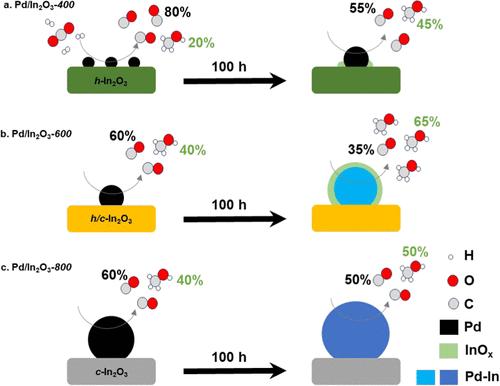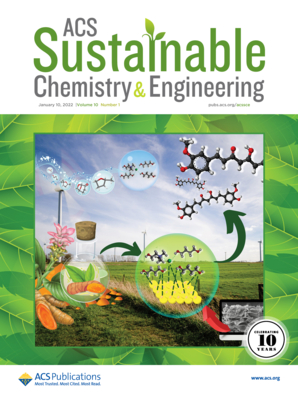Tuning Pd–In2O3 Interaction and CO2 Hydrogenation Activity for Methanol Synthesis via In2O3 Crystal Phase Engineering
IF 7.1
1区 化学
Q1 CHEMISTRY, MULTIDISCIPLINARY
引用次数: 0
Abstract
Engineering Pd–In2O3 interaction is key to developing catalysts with the desired CO2 hydrogenation activity toward methanol synthesis. Here, the crystalline phase of In2O3 nanospheres was tuned by changing the calcination temperature, which was found to affect the Pd–In2O3 interaction and thus the supported Pd states and CO2 hydrogenation performance of the prepared Pd/In2O3-a catalysts (where a refers to the calcination temperature for preparing In2O3). The fresh Pd/In2O3-a catalysts show varied initial activities, and after the induction period, their performance stabilized though being different. During the 100 h catalysis, catalyst microstructures changed, showing Pd aggregation and Pd–In alloying, which was related to the nature of the crystalline phase of In2O3. The hexagonal (h-In2O3) phase in Pd/In2O3-400 possesses concentrated surface OH groups and limited mobility. The relatively poor mobility limits Pd–In alloying, which possibly suppresses the hydrogen spillover effect, causing low CO2 conversion (8%) and methanol selectivity (45%) under steady-state conditions at 5 MPa and 300 °C. Conversely, the cubic In2O3 (c-In2O3) phase promotes Pd–In alloying and modifies Pd–In2O3 interaction during the reaction. The activity data show that Pd/In2O3-600 with the mixed phases of In2O3 (h/c-In2O3) demonstrated appropriate Pd–In2O3 interaction, leading to the Pd core InOx shell structure with the comparatively best methanol selectivity of about 65% at steady state. Conversely, Pd/In2O3-800 with the pure cubic In2O3 (c-In2O3) phase and a relatively low specific surface area of 16 m2 g–1 encourages the sintering of Pd and thereby the formation of homogeneous Pd–In alloys, having a moderate methanol selectivity of about 50%. These findings highlight the importance of the In2O3 crystal phase engineering in the catalytic CO2 hydrogenation over Pd/In2O3 catalysts and the dynamics of Pd–In interactions, which affect the methanol yield.

通过In2O3晶相工程调节Pd-In2O3相互作用和CO2加氢活性合成甲醇
工程钯-铟相互作用是开发具有所需的二氧化碳加氢活性的甲醇合成催化剂的关键。本文通过改变焙烧温度来调整In2O3纳米球的晶相,发现焙烧温度会影响Pd - In2O3相互作用,从而影响Pd/In2O3-a催化剂的负载Pd态和CO2加氢性能(其中a为制备In2O3的焙烧温度)。新鲜Pd/In2O3-a催化剂表现出不同的初始活性,经过诱导期后,它们的性能虽然有所不同,但趋于稳定。在100 h的催化过程中,催化剂的微观结构发生了变化,表现为Pd聚集和Pd - in合金化,这与In2O3的晶相性质有关。Pd/In2O3-400中的六方(h-In2O3)相具有集中的表面OH基团和有限的迁移率。相对较差的迁移率限制了Pd-In的合金化,这可能抑制了氢溢出效应,导致在5mpa和300℃的稳态条件下CO2转化率低(8%)和甲醇选择性低(45%)。相反,立方In2O3 (c-In2O3)相促进了Pd-In的合金化,并改变了反应过程中Pd-In2O3的相互作用。活性数据表明,Pd/In2O3-600与In2O3的混合相(h/c-In2O3)表现出适当的Pd -In2O3相互作用,导致Pd核- InOx壳结构在稳态下具有相对最佳的甲醇选择性,约为65%。相反,具有纯立方In2O3 (c-In2O3)相和相对较低的16 m2 g-1比表面积的Pd/In2O3-800促进Pd的烧结,从而形成均匀的Pd - in合金,具有约50%的中等甲醇选择性。这些发现强调了In2O3晶相工程在Pd/In2O3催化剂上催化CO2加氢中的重要性,以及影响甲醇收率的Pd - in相互作用动力学。
本文章由计算机程序翻译,如有差异,请以英文原文为准。
求助全文
约1分钟内获得全文
求助全文
来源期刊

ACS Sustainable Chemistry & Engineering
CHEMISTRY, MULTIDISCIPLINARY-ENGINEERING, CHEMICAL
CiteScore
13.80
自引率
4.80%
发文量
1470
审稿时长
1.7 months
期刊介绍:
ACS Sustainable Chemistry & Engineering is a prestigious weekly peer-reviewed scientific journal published by the American Chemical Society. Dedicated to advancing the principles of green chemistry and green engineering, it covers a wide array of research topics including green chemistry, green engineering, biomass, alternative energy, and life cycle assessment.
The journal welcomes submissions in various formats, including Letters, Articles, Features, and Perspectives (Reviews), that address the challenges of sustainability in the chemical enterprise and contribute to the advancement of sustainable practices. Join us in shaping the future of sustainable chemistry and engineering.
 求助内容:
求助内容: 应助结果提醒方式:
应助结果提醒方式:


